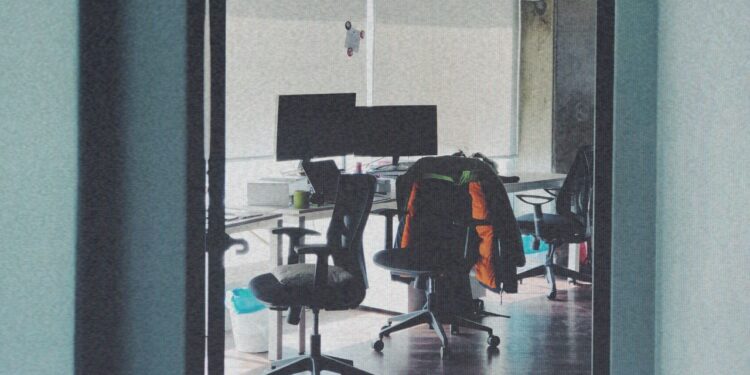- Peak occupancy tracks the number of employees physically present in the office at a given time, usually, this data comes from the busiest and most crowded parts of the day.
- Before the pandemic, peak in-office occupancy reached 79% in 2019. In 2022, peak occupancy never exceeded 33%.
- This indicates that RTO numbers have flatlined, but could this mean we’ve seen the bottom?
According to a LinkedIn webinar about flatlining RTO numbers, the height of office occupancy peaked in 2019 at around 79%.
Naturally, the pandemic changed things.
Instead of working in-office, employees started working remotely and transitioned to flexible work arrangements, and in 2022, peak occupancy never exceeded 33%.
Now, we’re halfway through 2023, but these numbers are flatlining.
Peak occupancy has jumped up to almost 50%, but surprisingly, the month-to-month change has decreased, which traditionally means that we’ve reached a bottom.
In stock analysis, a bottom is “the lowest price traded of a particular stock within a specific time frame.” RTO numbers aren’t stocks, but we can still apply some of the same analysis to these numbers in an attempt to determine what trends will follow.
Typically, when a stock has bottomed, it means that positive price action is on the way. Could this mean that RTO is due for an increase?
In-office work before and after the Covid-19 pandemic
According to the U.S. Census, less than 6% of Americans were working remotely before the pandemic.
This 5.7% of individuals had been steadily increasing for years, but without any real reason to allow workers to leave the office, there was never a tipping point that caused Americans to work remotely en masse.
In other data released by the U.S. Census, remote work took almost two decades to go from 3.3% in 2000 to 5.7% in 2019.
The pandemic changed this. Once Covid-19 became a widespread fear and government lockdowns commenced, the number of remote workers shot to just over 30% in 2021. Considering that 60% of U.S. workers are unable to work remotely, this was a considerable uptick.
Unsurprisingly, in-office work has had an inverse relationship with strengthening remote work numbers. In 2019, despite remote work’s slow and steady rise, in-office work was the norm. Employees were expected to come to work five days a week and, regardless of whether they liked it, didn’t have any other options.
Simply put, in-office work was the standard for American employees. The NCCI reported that 75% of American workers had never worked remotely before Covid-19. This all changed when the government started forcing business closures and deeming particular businesses “essential” to prevent the spread of the virus.
The above statistics were quickly eclipsed by the focus on remote work. Companies like Forbes posted articles claiming that remote work was considerably more productive than in-office work while employees all over the world championed healthier working environments.
Somewhere in the confusion, remote work became synonymous with freedom and in-office work became the antithesis.
Utilization vs. peak occupancy
To determine whether or not flatlining RTO percentages are a positive indicator or not, we need to first determine the difference between utilization and peak occupancy.
Peak occupancy tracks the number of employees physically present in the office at a given time, usually, this data comes from the busiest and most crowded parts of the work day.
Utilization measures the degree to which office spaces are being utilized or put to productive use by employees. Utilization assesses percentages and ratios of employees present in the office in comparison to the total capacity or available workspace.
This means that even if peak occupancy is high, there’s no guarantee that the workspace is being properly utilized.
When looking at utilization vs. peak occupancy, most employers would rather have an office filled with working individuals rather than an office that touches peak occupancy once a week and returns to low percentages just as quickly.
As RTO percentages bottom, increasing utilization may be simpler than you think.
Should C-suite executives consider a change of venue to boost utilization and, by extension, RTO?
One of the problems with traditional technical analysis is that you don’t know whether you’ve seen a bottom or a top until after the fact. Even in April 2021, publications weren’t talking about the “top” of remote work until months after the fact.
There are many methods that traders use to determine bottoms in real-time, like an increase in volume, the reclamation of moving averages, “higher lows” — or the stock remaining higher than the determined bottom, and major indicator confirmation.
Applying these methods to RTO percentages isn’t perfect, but the slowing of month-to-month change in conjunction with “higher lows” — or the steadily increasing peak occupancy numbers, are positive indicators.
Dave Cairns, entrepreneur and Senior Vice President of CBRE Canada stated that companies need to focus on utilization and asynchronous schedules, which are a huge part of why remote work is so successful, more than they need to focus on simply bringing workers back to the office.
The peak occupancy numbers show that even if workers are returning to the office, many of them aren’t working when they’re there.
To take advantage of primed RTO percentages, businesses need to focus on redefining how we work and when we work, and then, they can focus on how to get workers to work where they want them to be.


 Dr. Gleb Tsipursky – The Office Whisperer
Dr. Gleb Tsipursky – The Office Whisperer Nirit Cohen – WorkFutures
Nirit Cohen – WorkFutures Angela Howard – Culture Expert
Angela Howard – Culture Expert Drew Jones – Design & Innovation
Drew Jones – Design & Innovation Jonathan Price – CRE & Flex Expert
Jonathan Price – CRE & Flex Expert













